IMDB meta data: run time 1 and 45 minutes; scored at 7.3/10 by a paltry 124 voters.
‘Coming sooner than you think,’ is the opening title card. About time, cried the fraternity brothers!
Made fifty years ago, this film is an anticipation of reality television, even before ‘Death Watch’ (1980).

The set up? The televised trials for a place at the next world Sex Olympiad are underway in a television studio. Watched from a control room by the bored producers, clad in paisley pajamas, who are dedicated to keeping the viewers apathetic in a society where
‘it is better to watch than to do.’
They watch and so do we. The vicarious sex on the telly is to sate the libidos of the audience so that there is less reproduction. (Pornography has never done that for the fraternity brothers.) There are other sex program catering to the artistic. Another program is aimed at reducing the appetite for food through custard pie throwing. Very Three Stooges. There is a joke about this in the credits with a long list of consultants on pie throwing, including Bernard from ‘Yes, Minister.’
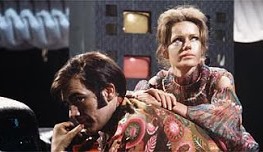 Those jammies.
Those jammies.
In general the purpose of television is to quell the emotions, drives, and impulses of people because they cause conflict. The goal is a quiescent society. like Canberra on Saturday night.
This situation has gone on so long that the current generation we see no longer seems to know the larger context or purpose or the historical evolution of the industry and the society it serves. It just is this way.
Everyone speaks a clipped functional language. The television producers are High-Drive people. The audience they cater to consists of Low-Drive people, the vast majority. That translates readily to the world of Channel 7Mate where the producers cater to an audience they despise and make millions doing it. No one goes broke underestimating the tastes of that demographic where urine drinking is a competitive sport.
Finding the balance in this television game is tricky. Nat with eyebrows that often speak for themselves is pressured from above by the Controller, a standard BBC term, to improve his programs and threatened from below by a underling who wants his job. Situation normal in an organisation but mercifully this depiction is pre-KPI so there is no cloudy and vague McKinsey-speak further to confuse matters in the name of clarity.
Two disruptions occur. First an artist arrives in the studio and he wants to upset people with horrifying pictures. Think of Evard Munck’s ‘The Scream’ or the Twit in Chief smiling. Ugh! These people are indeed horrified by the art. The studio High-Drives are so cocooned they have never seen an unpleasant sight. The artist tries to disrupt a broadcast to show one of his pictures and becomes one himself when he falls to his death!
Eyebrows, however, finds the pictures fascinating, albeit unsuitable for broadcast. He is, perhaps, not quite as superficial as he seems, then into his life comes a personal crisis when a child by his first wife is tested as Low-Drive, which will reflect badly on him. He has no interest in Ex or Child except as they show in his file. He is a very model of a modern McKinsey manager avant le mot and only thinks of his KPIs.
The idea emerges of isolating a couple on a deserted island amid cameras so that viewers can watch them cope. Eyebrows and Ex volunteer with Child. These three missed Scouting and know nothing. They do not know what fire is let alone how to start and maintain one or to pull a vegetable out of the ground on the windswept rain-soaked island in Holland Park to which they are consigned.
They have copious instructions from Wikipedia on an iPhone which are frequently consulted. Eyebrows had an iWatch in the studio bit he did not take it to The Island where he went low tech.
The program is called ‘Living Life.’ The audience finds it amusing and it is a hit. The audience by the way is represented by a focus group of twelve garbed in pink sweatshirts and pants. These are the Low-Drives of Channel 7Mate.
Without the professor from Gilligan’s Island, Eyebrows and Ex are hopeless. They have been spoon fed so long that they only know the shape of the spoon. Child falls, breaks an arm, and slowly dies of an untreated infection.

The sweatpantsers find that hilarious. Ratings soar. (See, like ‘Death Watch.’)
The inevitable comparisons are the E.M. Forester story ‘When the Machine Stops’ and George Orwell’s ‘Nineteen Eighty-Four.’ Though as to the latter, there is no hint here that there is a regime oppressing people per Orwell but rather a commercial enterprise giving the Pink Sweatpants Nation what it wants, when it wants it, and how it wants it. Is not that broadcast populism, or democracy? Responding to what the people want is one definition of democracy.
This is another gem from the fecund typewriter of Nigel Kneale. The players include Reginald Perrin and the estimable, but here very young, Brian Cox. I found it on the Internet Archive.
It was filmed in colour but only a black and white archival print remains. The expensive colour film was reused though why the BBC did it in costly colour at a time when there very few colour televisions to see it on is anyone’s guess.
Inspired by this viewing, I will look for ‘Death Watch.’
Category: Film Review
‘Space Trucker Bruce’ (2014)
IMDb meta-data, 1 hour and 27 minutes, rated 5.1/10 from 60 voters.
A road movie in space as the lonely space trucker Bruce with 20,000 tons of Iowa hog fat picks up an escape pod passenger. Not quite a hitchhiker but close to it.

They get to know each other and then they encounter The Dark Object and they struggle to survive. They bond. Bruce is in the Channel 7Mate demographic.
Moral, space travel is boring. Subtext, watching boring space travel is boring.
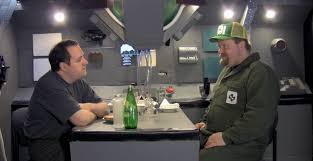
Very.
This is a no budget exercise written, produced, directed by one of the actors. See. It was posted to You Tube by the maker by way of a release.
I managed to watch it to the end but then, strangely, forgot about it until now quite a time later.
Not to be confused with ‘Space Truckers’ (1996), which on the IMDb ranks at 5.2 or a mere 0.1 higher despite its much bigger budget and some fine actors, e.g., Dennis Hopper, Charles Dance, and more.
‘Mission Stardust’ (1967)
IMDB metadata: 1 hour and 37 minutes @ 3.9 from 479 friends of the producer.
Half Sy Fy and half an ersatz James Bond thriller from Italy.
 ‘Staggering?’ No more like numbing.
‘Staggering?’ No more like numbing.
The first Earth flight lands on the Moon, and its four-man crew sets out to do some science, collect samples, survey, map, and gawk at Terra. (They do not light up.) But they are not alone!
There is another ship, a round June bug with external retracting landing gear. The fraternity brothers thought it was cute, more so later when it gave birth.
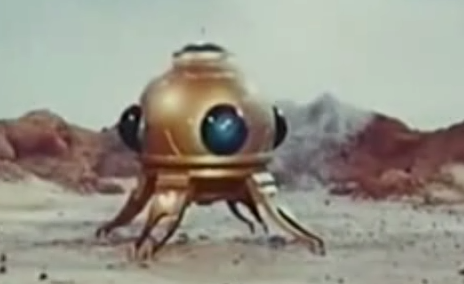 The June bug on the Moon.
The June bug on the Moon.
After a standoff, two of the Terrans meet the aliens who are as insecure as Ivy League graduates who have to tell everyone immediately and repeatedly that they are Ivy League graduates, and boast again and again about their superiority to the Earthlings. Superior, maybe, but tactful not. The chief proclaimer is a chump-cha Twiggy in a platinum wig. In addition there is a wise old owl, and robot who seems nicer than Twiggy and smarter looking than the wise owl. Pretty sure that wig was used again later in ‘Sette uomini d’oro nello spazio’ or ‘Star Odyssey’ (1979) without Twiggy underneath.
‘Superior,’ did she say, time after time, and yet they can’t change a tire on the spaceship, which is why it is stuck on the Moon waiting for some road service retards from Earth to wander by. How superior is that! The Terrans volunteer to change the tire, while Twiggy repeats the scriptwriters mantra. Owl gets all faintly and the Terra doctor notices he has leukaemia. Tire changing will do that.
Twiggy and the Earthmen join….forces to treat the disease in the owl. Because they are so superior the aliens have neither a doctor nor medicine. Did she say superior? Well maybe it is a superior form of leuekmia, which the fraternity brothers thought mainly afflicted the young. Mr Owl is no spring owl.
Best treatment for leukaemia on Earth is to be had in Mombassa. Mom bosa? In Kenya. Sure.
The big June bug ejects a mini June bug and an away mission to land in east Africa. Twiggy brings along one of the really big-button remoters for geriatrics just in case. Superior technology, not! It gets put to good use.
The wise old owl goes on about the union of the two peoples of Earth and owls. The fraternity brother responded to that idea with enthusiasm.
There we switch to James Bond, complete with a villain sporting mirror-shined loafers and stroking a hairy pet. Blofeld slumming. Another wanna-be villain.
It’s like this. The Superior Beings with a flat spaceship tire and leukimea have a stash of diamonds. Blofeld knows this because one of the four Earthmen contacted him to rat it out. (Disclosure statement, I fast-forwarded past this revelation, so that is my interpretation based on what happens next.) Blofeld also knows that they are going to the clinic so he plants his killer nurses there with Uzis up their… It’s a trap!
Earlier the army had wasted screen time trying to blow up the ship, the robot, and the director’s chair. Something. Anything.
Later there is confrontation and shoot out on the Moon. The traitor gets it. Blofield gets it. Twiggy gets it.
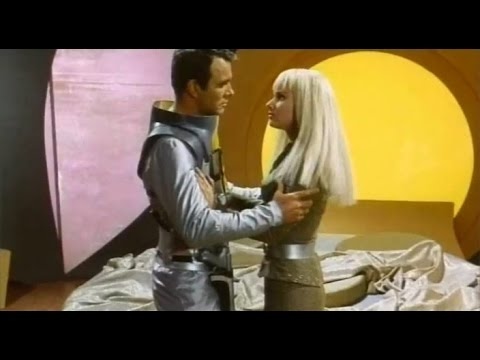 Union at last. The end.
Union at last. The end.
Never seen anything quite like it. It is a genre mongrel, part drive-in Sy FY and part low-budget James Bond. There are other mongrels in the Sy FY kennel, usually noir thrillers like ‘The Atomic Man’ or ‘The Amazing Transparent Man’ and others that blend with musicals, krimis, ghost stories, and …..
The levitation effects were fun. The robot unmasking was neat. The June bugs large and small were cute. It must have used everyone in Kenya as an extra.
But, really, 3.9 seems high.
‘Zontar: The Thing from Venus’ (1966)
IMDb Metadata 1 hour and 20 minutes of Dali Time, rated 3.0/10 by 670 time wasters.
‘It Conquered the World’ (1956) was Zontar’s first effort at Terra domination. But Zontar had a sibling and here it is. Sexing Venusians is beyond even the fraternity brothers, so we will leave it at ‘It.’
The Dallas production company copied ‘It Conquered the World’ nearly line by line and scene by scene, except at the coda. It is not a continuation of the previous story but a tired and trite repetition of it. The plagiarism is so literal that it even includes the same 1950s ethnic accents for some of the most minor characters. However, the decor, fashions, hair are all of the 1960s.
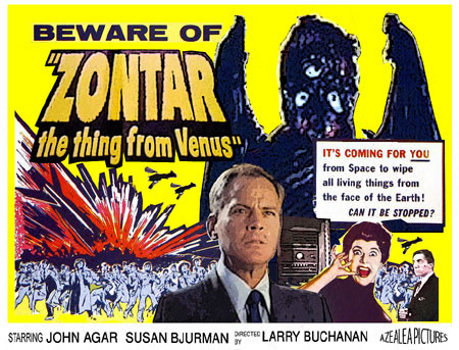
John Agar, about whom more below, saves the world once again, single-handedly as he prefers. This is done after his wife and his friend try to kill him. Macho Man that he is, he kills his wife, but bonds with his friend. Is this man-love?
The acting is uniformly wooden. Agar is the exception; he is robotic: stiff and mechanical.
Copied yes, but the homily at the end differs. Most Sy Fy films have some kind of coda. At the end of ‘It Conquered the World’ Peter Graves told audiences that humanity would prevail because humans have feelings, emotions, compassion,…. [ad nauseam]. In this outing, Agar’s text does not celebrate all that girly New Testament stuff, but declares humanity will endure because we think, reason, do science, and such. Hooray! Banned in anti-Vaxxer states across the nation.
That pulled me up short. While ‘It Conquered the World’ is a better movie, this is a better message.
‘It Conquered the World’ is a better movie at 4.9 on the IMDB opinionmeter, though in the basement, because it has much more energy, vitality, momentum, and tension than this leaden exercise.
Once again John Agar’s (1921–2002) feet do not touch career bottom. He kept it up for nearly another forty years! For a man who was second to John Wayne in ‘Fort Apache’ (1948), ’She Wore a Yellow Ribbon’ (1949), and ‘Sands of Iwo Jima’ (1949) this is a long way down. After marrying America’s sweetheart, Shirley Temple, he found a greater love in the bottom of innumerable bottles of alcohol, so the story goes, and that love ended his marriage and put dent in his career.
The titles indicate the substance of this selection of his oeuvre.
‘Revenge of the Creature’ (1955)
‘Tarantula’ (1956)
‘The Mole People’ (1956)
‘Daughter of Dr Jekyll’ (1957)
‘The Brain from Planet Arous’ (1957)
‘Attack fo the Puppet People’ (1958)
‘Journey to the Seventh Planet’ (1962)
‘Women of the Prehistoric Planet’ (1966)
‘Curse of the Swamp Creature’ (1966)
In most of them he played an authority figure, a scientist or an army officer, something he never was.
That career came as a result of his marriage. After he married Temple, her studio hired him, put him through acting school, and cast him in his first film, ‘Fort Apache.’ When she divorced him friends like John Wayne tried to help him with work but the shambles continued. Despite it all he kept acting, in his way, when not in jail for drunk driving, assault, harassment, stalking, petty theft, and such, yet he has a long list of roles on the IMDb, the last released in 2005 after his death. He is another Hollywood high diver. Started out on top and plunged to the bottom in no time at all.
According to the cinema oracle, IMDb, there is a Zontar Television series. Tempting….
‘Invisible Invaders’ (1959)
IMDB metadata 1 hour and 7 minutes @ 5.0/10 from 1246 time wasters.
‘The aliens are coming! The alien Russians are coming!’
 The lobby card misleads. As usual. There are no zapping flying saucers.
The lobby card misleads. As usual. There are no zapping flying saucers.
The Cold War is very cold and John Carradine, with his cadaverous appearance and other worldly voice, leads the spooks once again.
He was a nuclear scientist who adds sugar to his radium and blows himself up. Sad. His dear friend and colleague ruminates on the morality of atomic weapons in the aftermath with his comely daughter and Igor. B o r i n g.
To liven things up comes the Zombie Carradine, looking even more cadaverous and spooky than ever with the pancake makeup. No, he does want a cup of coffee. He is there to lay down the law. His dead body has been put to work.
This Lazarus is speaking for the otherwise Invisible Invaders (the I-Squares) who live on the Moon, and have done so for squillions of years (without paying a cent of rent). Not even the really big telescope at Mount Palomar that Bruce Bennett used when Carradine was the ‘Cosmic Man’ (reviewed elsewhere on this blog) could see them or their works. They are INVISIBLE. (That is music to the film’s producer because it means no special effects budget is required.)
Indeed the main effect is shuffling foot prints so we know the Zombie alien is coming. It seems the Zombies are invisible, too, well, some of the time but not always. Consistency is not a Zombie virtue.
The budget cutters have been at work on the Moon, and to economise the I-Squares are using the Earth’s dead as Zombies. We are told often in a radio voiceover that there are hordes of them rampaging around killing the living to convert them into Zombies to meet their KPIs, Killing Performance Indicators. Yet we only see six of them, all men in suits with neckties and all of them 1950s whitebread. We see them about six times. It looks like two takes, repeated and repeated, one coming down a slope and one on the flat, all in Bronson Canyon. The property values never recovered from this exercise.
Why do the I-Squares want to depopulate the Earth? Are they anticipating the Solar contamination of Paris Hilton? The fraternity brothers have no idea. Situation normal.
Carradine is not there to negotiate, just to threaten. He tells his ruminating old buddy to call on world leaders to surrender and be quick about it, which his buddy does by going to D.C. to pass the word where he is laughed out of court. The carrion the press join the fun with spinning newspaper headlines. Situation normal.
Though the threat is global we only see the Yankee response. Not just whitebread, but only Yankee whitebread.
‘No more Mr Nice Guy,’ declares an disembodied Carradine (whose body has now gone onto to another gig), and the I-Squares begin inflicting disasters on the world. First, they take ‘I Love Lucy’ off the air and riots follow. Then they cause the New York Yankees to lose the pennant. Can it get any worse?
Yes, Richard Nixon gives speeches. Aaargh! Enough. There is stock footage of fires, floods, and famines that result from Nixonionisms.
Now D.C. responds by throwing all the resources of the mighty Federal government into the problem. These resources are: one ruminating, aged scientist, his assistant Igor, his daughter who bites her knuckles, and John Agar, proving there is no bottom to touch in his career descent. There is also one jeep and a panel van, and one, only one, radiation suit. That’s it. The Boy Scouts were always better prepared for Armageddon than that.
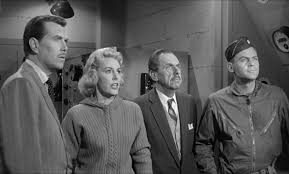 Life on Earth depends on these people!
Life on Earth depends on these people!
This is the Arsenal of Humanity? Blame the budget cutters! Fortunately, they have an in with the script writer. Plus now that Carradine has gone, the Zombies are not only stiff-legged, they are stiff-brained. There is no ethereal voice to scare everyone.
Despite the absence of Whit Bissell from the lab, the aged scientist hits on the killer weapons for the undead dead Zombies whose bodies are inhabited by the spectral I-Squares.
Taking a page from Bissell’s lab manual in ‘Target Earth’ (1954) (reviewed elsewhere on this blog), the aged ruminator prepares a sound ray. (Hey, that is what it is.) It focuses Beach Boys songs onto the Zombies and the ‘Good Vibrations’ are too much for them. They are driven from the cadavers and die. Die, alien, die! The fraternity brothers liked that.
Igor chickens out but recovers. From this episode we know he has no chance with the knuckle-biter. Agar sleepwalks through most of it, and his stunt double in the radiation suit does the heavy lifting. But there is no doubt he got the girl.
While the I-Squares are Reds in invisible disguise, they are so geriatric with all the foot dragging that, well, they would fall over their own feet. If left to roam around they would eventually do themselves in.
The sets are empty. The film editing leaves in much that should have omitted, like the firing range targets in some of the explosion footage. Most of the, er ahem, story is told through radio voiceovers. Always a sign there is no sound technician getting paid. The direction is static, usually a sign of one-take. No one moves once the focus is set, so that it does not need to be pulled again. The screenplay is…. (what is the right word…) absent.
John Carradine must have been working off some gigantic karmic debt in doing all these one and two day gigs in Z grade films. This would have been half a day for an old trouper like him.
John Agar, well, what more can be said. He is another Hollywood high diver. Once a second lead to John Wayne, he fell to these catatonic depths. He is leaden here, no doubt responding to the director’s orders. I have described his descent in another post.
The director is that speed merchant Edward L. Cahn who could turn these things out in five days or less, much loved by producers for getting it in the can. He could do fifteen of these a year, but no one can watch that many in a year, and retain sanity. I could not find a picture of him on the inter-web.
That the IMDbasers give it a 5.0 average irritates, since the better ‘The Cosmic Man’ (1959) is 4.7 where Carradine brings an interplanetary Marshall Plan.
‘The Cosmic Man’ (1959)
Metadata from IMDB: 1 hour and 12 minutes, 4.5/10 from 302 opinionators
A shadowy figure offers world peace and an interplanetary Marshall Plan, while curing a polio-stricken youngster, and in return is then gunned down by men in uniform. Ah, the 1950s when the worlds were so much simpler.
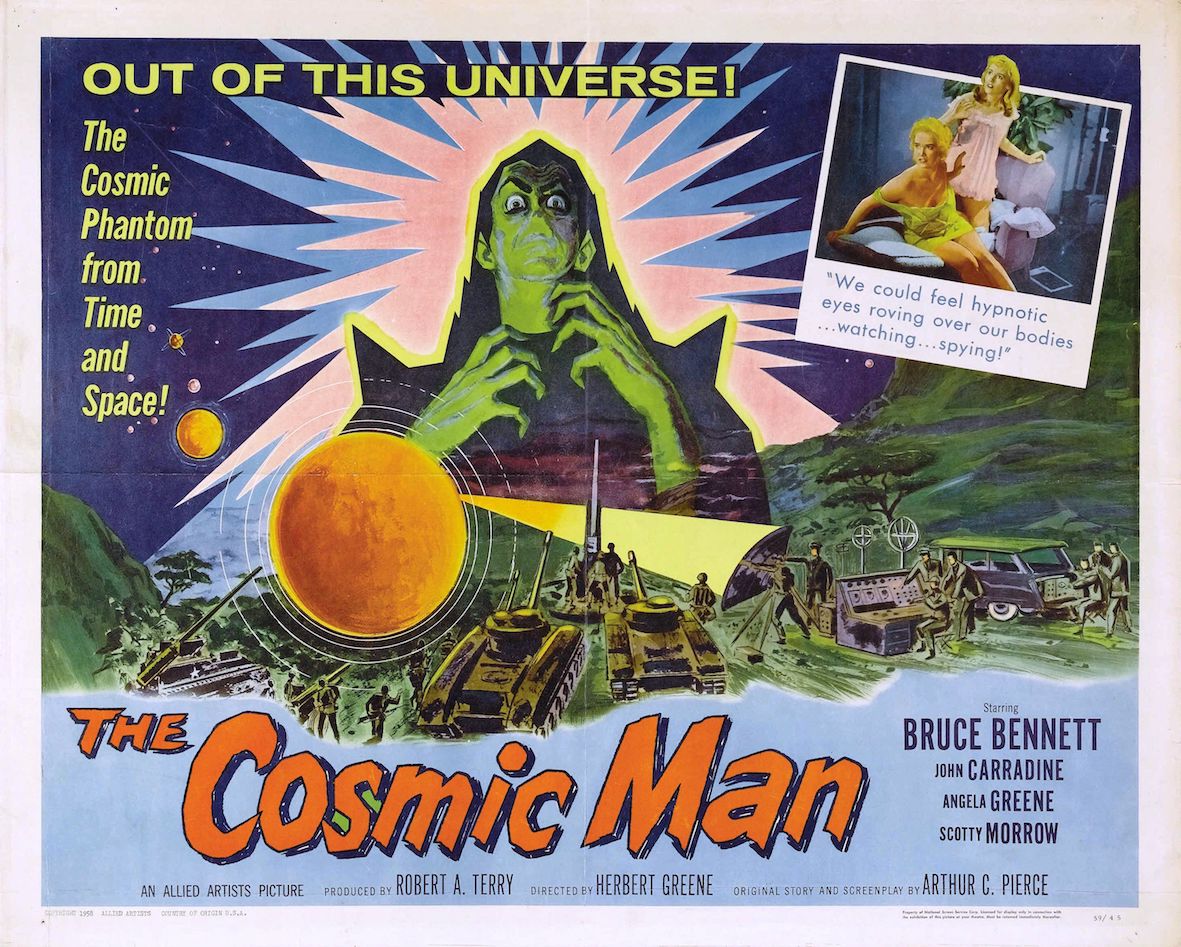 This lobby card wins first prize for irrelevance to the movie it purports to summarise. There is no spectral green figure in a cape, and the insert in the upper right refers to a ten second blur.
This lobby card wins first prize for irrelevance to the movie it purports to summarise. There is no spectral green figure in a cape, and the insert in the upper right refers to a ten second blur.
While it repeats the tropes from many of its Sy Fy genre stablemates there are elements that appeal to viewers over the mental age of the fraternity brothers. (Think of them as part of Channel 7MATE demographic for whom ‘Top Gear’ is high culture.)
Before the twists, the set up. An orb is found suspended in mid-air in Bronson Canyon, a favourite Hollywood locale where Randolph Scott dealt with many a villain.

It looks like a large golf ball without the dimples.
‘Can’t have that,’ declares Smokey, the park ranger. It might fall on someone. Unbeknownst to millions of visitors to Bronson Canyon there are many secret atomic military bases in the vicinity, and Smokey calls in the police and they call in the uniforms. A Commie plot is suspected in all but word. No one thinks to call Sam Snead, the golf ball expert of the day.
Someone also calls in Herbert Brix, a scientist from Mount Palomar, who is shown driving out of the parking lot of this famous installation, not once but twice, in exactly the same film footage. There are no interiors of the big telescope there.
Thereafter the colonel on the scene and the scientist spar over what to do. The colonel wants to contain, capture, control, crush, cut, and do other manly things to the sphere, which continues harmlessly to hover.
Brix wants to think, to look, to inspect, to test, to speculate, and to do science, perhaps even communicate with the owner of the golf ball.
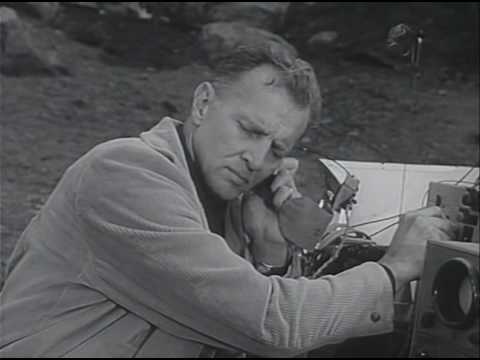
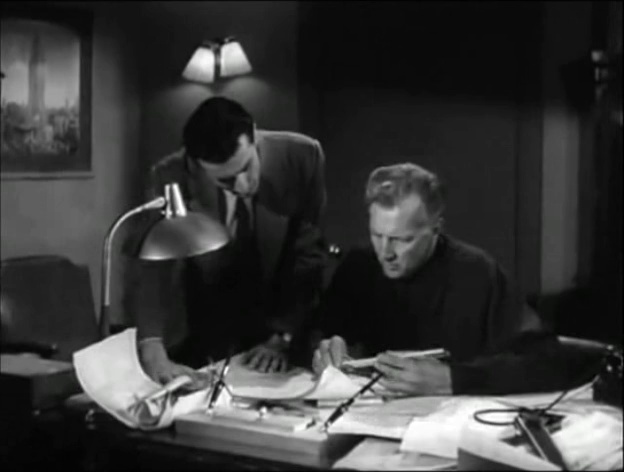
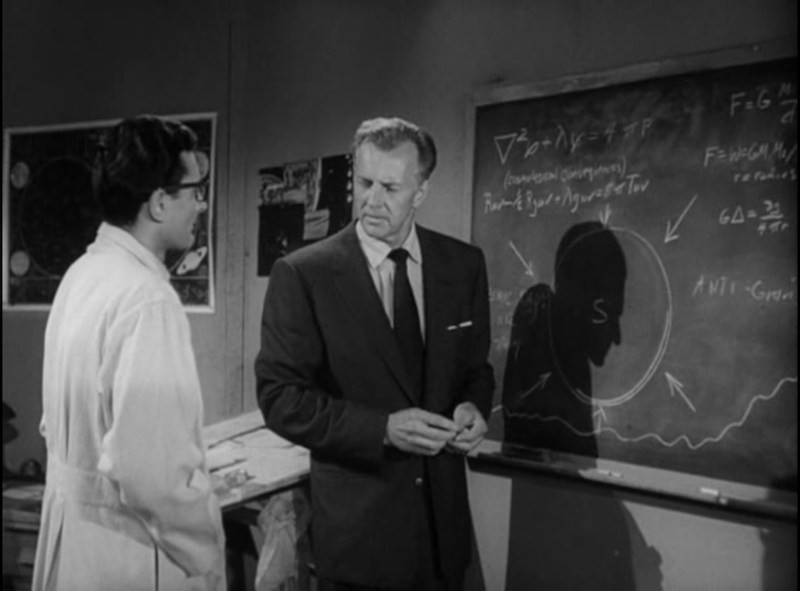 Brix doing science.
Brix doing science.
‘Thinking! Who has got time for that,’ bellows the colonel! ‘It is a threat!’ (The fraternity brothers have always had their suspicions of golf balls because they always seem to be guided by unseen forces.) But the colonel’s efforts, adumbrated above, are ineffective, so reluctantly he listens to Brix.
Brix surmises from no evidence apart from the script that the golf orb came in peace and is a vehicle and that its passenger has disembarked through the forward, invisible door. The colonel telephones the general, who is too lazy to come and see for himself, for ever more soldiers to find this infiltrator. A cordon bleu is thrown about Bronson Canyon much to the annoyance of Charles who lives there.
The soldiers and more scientists converge on the spot and put up in an inn whose widowed proprietor has a crippled son of, say, ten or eleven. Dad was canceled in the Korean War a few short years earlier and the widow took the payout and bought the inn where she can attend to her boy. It is out of season but now she has a full house. Cha-ching goes the cash register.
Meanwhile, a peeping Tom seems to be about, causing much consternation among the citizenry who pressure the police, who pressure the mayor, who pressures the army which pressures the scientists. Much pressure to Do Something.
With all the coming and going at the inn another fellow shows up, rugged up in an overcoat, a floppy hat, and wearing coke bottle glasses.
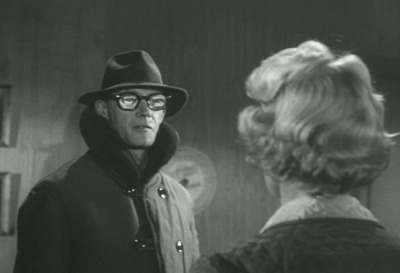 What else could he be but a scientist in that regalia.
What else could he be but a scientist in that regalia.
He speaks in the voice of John Carradine. Shiver. He speaks ever so slowly and formally that we know right away he is not of this vernacular. The widowed proprietor mistakes him for another scientist and gives him a room in the back where he can rest. We know he is golfball orb lagged from his travels.
Brix tries to reason with the colonel, and the colonel listens and even rebuts part of Brix’s argument. Nice. Reason.
Enough! Carradine’s two-day contract means he has to hurry up and spill the cosmic beans. When the whole group is gathered in the inn, JC dowses the lights and reveals himself as the Comic Man, the first of the cosmonauts. Yes he uses that last term, which latter became identified with the Soviet space program so he must be a Commie. He warns against nuclear weapons and war, and offers the help of the Cosmonauts in development that will lead to world peace.
He does not exactly reveal his very own self since he is invisible, being from another universe, dimension, bad dream, or something. Or maybe he is the prodigy of the Invisible Man and Invisible Woman as reviewed elsewhere on this blog.
To Brix this message fits with the low key way the Cosmic JC has been going about things. First Contact is always tricky in Sy FY. First the alien has been trying to scout the place, steal some of clothing, and drink some coke to get those glasses.
To the colonel it is Yalta all over again, once more. This peace will be slavery. Better dead than contented! That seems to be his motto.
Meanwhile, JC has taken a liking for the crippled boy who teaches him to play chess. Nice.
Having seen enough, JC prepares to depart. In so doing he takes along the boy! Alien-napped! A hostage! The worst possible interpretations flow fast and furious. The colonel is ready to nuke the place! Better to destroy the boy than lose the boy.
JC puts aside the boy and as he alone approaches the golf ball orb he is blasted by the United State Army! Makes a Twit proud to see one harmless old man chopped down.
In a nice touch, the switch is not thrown by the colonel, but by another scientist called in by the colonel because Brix is such a sissy. This scientist does it, he says, because he want to detain JC. Ah huh. Intentions aside. JC is cooked. He disappears into the dust, and blink, the golf ball orb is gone.
The boy, on his feet, walks to his mother because he is now cured of his disability.
Whew.
It was not clear to this jaundiced viewer if the colonel got the message about the boy, or if he cared.
Nor is it clear what the other cosmonauts will do now that JC is dust. But no one in the script seems worried about that.
Meanwhile, the slow but sure Brix has insinuated himself with widow. The colonel can tell the general he will not have to move.
It is easy to see this tale as social criticism applied to the trigger fingers of all those uniforms. That was risky in those days of Cold War uniform worship.
It is also refreshing in the Sy Fy genre to see a scientist who is not mad and who is not completely ineffectual. The colonel, having seen many other Sy Fy movies supposes Brix is ineffectual because he does not understand what Brix is doing. In fact, his science is what provokes JC into revealing himself and it is mainly to him that JC speaks. This annoys the bristling colonel no end. He and his men try to shoot JC in the dark after hearing this Yalta message.
Generally in Sy Fy, there is no science at all, a mad scientist who started all the trouble, or a bunch of clipboard-carrying do nothing scientists. Brix is none of these.
His brief conversations withe colonel make sense.
One critic speculates the John Carradine must have been working off an enormous karmic debt by taking every part in every bad movie he was offered. He certainly did.
The critics linked to the IMDb page deride the film for its poor special effects. It is after all a magnified gold ball and some claim to see the dimples. The shadowy shots of the invisible Carradine are mostly murk. As a creature feature, it lacks a creature, despite the lobby card above. Moreover, there is little ka-boom to keep the retards happy.
However, its biggest sin on the keyboards of these critics is that it repeats the message of Klaatu from ‘The Day the Earth Stood Still.’ Peace on earth, good will, and harmony for all. ‘Boring,’ cry these critics. ‘Been done,’ they say.
What clots!
There are no original stories. It is how the tale is told that makes it interesting, and this low-key telling with some respect for science and scientists is out of the ordinary. The romantic element does not get in the way of the major plot, whereas in many films that would have been the cause of tension between Brix and the colonel. While the widow does a scream or two, she is mostly window dressing. The tension is about what to do and nothing else. The paraplegic boy is integral to the plot but not a tear-jerker.
That is, the elements are in balance and the focus is always on the main plot. Aristotle would approve.
It is noteworthy how little science there is in many Sy Fy films. The aliens appear and the cast blasts them. Sometimes a lab coated scientist, inevitably Whit Bissell, fine tunes the blaster and bang, that is it. In many, there is no science at all. They are played as mysteries, or thrillers. Period. ‘It Came from Outer Space’ (1953), a personal favourite, has no science in it, after Carlson puts aside his telescope in the first two minutes.
Herbert Brix, ever heard of him? He was an Olympic athlete whose physique led him to play Tarzan in a film serial when John Weissmuller beat him out for the feature film role. Brix liked the life but, unlike many, realised his limitations. He quit and took acting lessons for some time, and then changed his name to leave behind his he-man persona and became Bruce Bennett, and returned to become an accomplished supporting actor. This outing would have been one of his few romantic leads.
He has a easy manner, a slow smile, a reassuring baritone, and fills this bill well. He supported Bogart in ‘Sahara’ (1943), ‘Dark Passage’ (1947), and ‘The Treasure of the Sierra Madre’ (1948). He quit a second time and went into real estate in California and did well. He is described on Wikipedia as a recluse who did not attend fan conventions, do interviews, reply to would-be biographers, and such as many retired actors do. He stayed married for sixty-seven years and died at one hundred.
‘Creature from the Black Lagoon’ (1954)
1 hour 19 minutes: 7.0/10 from 20,081
It is a creature feature; it might even THE creature feature, but is it Sy Fy? Janne Wasse includes it on his Scifist because there is much pseudo-science in it about geomorphology, geology, geography, geostuff, topography, evolution, riverine systems, and the like. It is not the usual astronomy and space flight but it is science but there is not a mad scientist in sight.
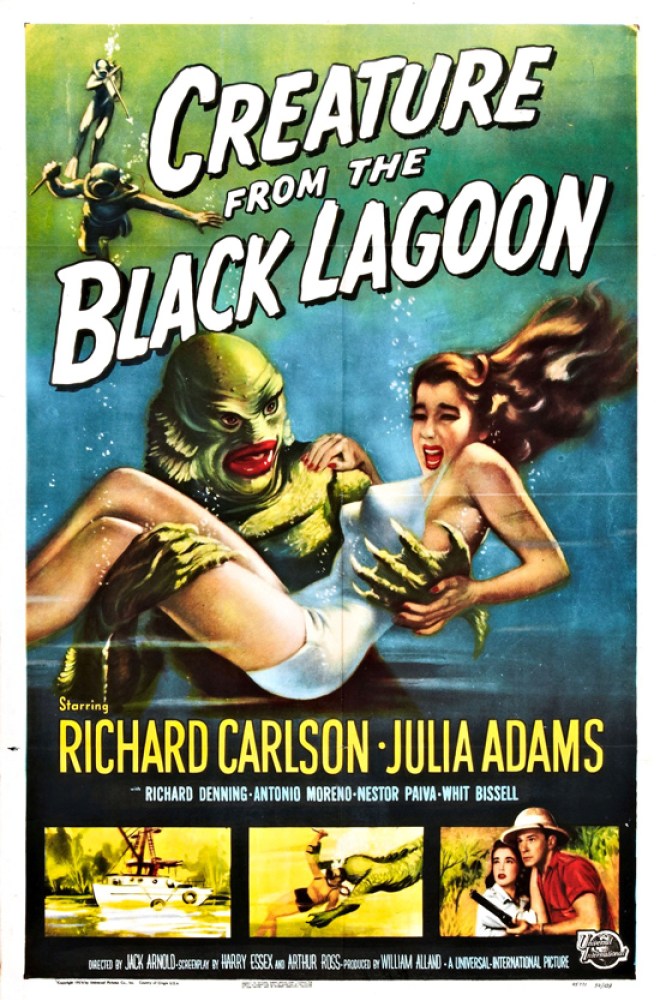
The title passed into the vernacular two generations ago, understood by people who have never seen the movie and do not want to do so, and it spawned two sequels in an era when such follow-ups were rarer than is today a good film from Big Hollywood. More than 20,000 ratings puts it in the inner circle for such films on the IMDb. The two sequels were ‘Revenge of the Creature’ (1955) and ‘The Creature Walks among Us’ (1956) to be watched only for those who pursue the complete set, say the experts. Note that the sequels each had a distinctive title without a number on the evident assumption that audiences could figure it out. Not so today when numbers guide the prepubescent ticket buyer: Rocky 19, CGI Crap 13.
Here is the set-up. A strange fossilised skeleton is found in the upper reaches of the Amazon River. So strange is it that the Americans on sabbatical leave nearby become interested. These Americans are Richards Carlson and Denning and Julie Adams. Denning is the dean of a research institute, and he is totally preoccupied with funding, whereas Carlson is a rock-chopper, and Julie is the theorist whose work is praised more than once as vital, though we neither see nor hear any of it. To gold plate the Sy Fy credentials they take Whit Bissell, ever a fifth wheel in such capers.
Antonio is the local man who hires the boat and crew. Nestor is the captain and he is ready when the chips fall. Equipped they return to the site of the discovery to find two of Antonio’s men slashed to death, as though a crazed Canberra budget-cutter had got them. Oh, oh.
Well it is a jungle and such things, if distressing, are to be expected so they continue and set a guard. Much sweating in the Jeff Bezos sun follows with no result. Then after seminar gobbledegook, they decide to go further up river into….the Black Lagoon. Nestor. having peeked at the script, is not so sure this is a good idea but the money wins the argument.
With scuba gear there is much arresting underwater photography. However, the highpoint, which every viewer remembers, is the parallel water ballet between the lissom Julie Adams on the surface with a backstroke and….the Creature in depths below mimicking her turns, evolutions, and strokes. These are hormones falling in love with a vision come to his dark, remote world.
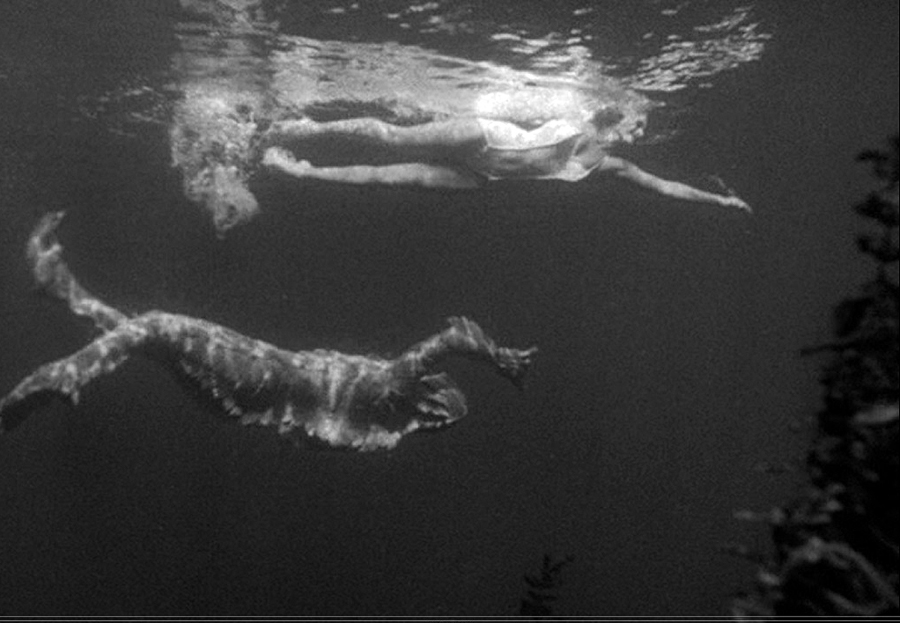
We know, by the way, that he slashed the peons earlier but we do not know why, and we never find out.
As Julie disports to wash off the hot day’s toil, she treads water upright to call to a Richard, and the Creature reaches for her foot.

It is delicate, almost shy approach. It tickles her toes and with a start, off she goes.
Julie and Carlson are a couple, very much so, but it is explicit from the near the beginning that they are not married. That was a risqué thing to say in a 1954 movie but there it is. They spend much time…together, when Denning thinks they should be earning his crust. There are words, low key but serious, about KMIs, Key Money Indicators.
Then a guard gets slashed and footprints are found from the Lagoon to the camp. The footprints are of a gigantic….creature!
Denning wants to capture it, seeing headlines and patrons throwing money at the institute. Carlson wants to take pictures of it (with largest iPhone ever seen) and come back with specialists to study this merman, a link to our primordial past, as heralded in the opening voiceover. (Not on the Fundamentalist list of top movies this one since it has much to say about evolution from the seas.) Julie wants to communicate with it but how…? An SMS? Antonio wants to get back for soccer game because Pelé is playing. Nestor wants to get paid. Whit Bissell patiently waits for a cue as supporting actors must.
Then, suddenly, it does not matter what they want. The Creature kills another peon, then after hiring a beaver as a consultant, damns the entrance to the Lagoon. They will have to fight their way out. They do. Denning is fish food, after saving Carlson, who saves Adams from a fate worse than a GOP majority.
The fraternity brothers counted: three missiles from the underwater spearguns stick in the Creature, he was shot three more times by a rifle from a distance, scorched with flaming kerosene, and blasted innumerable times up close by pistols, and still he went on. With skin this thick, he should be the dean.
For its time and setting, it is notable than all the peons had names, and the one who is wounded remains with the crew in the care of Julie, who as a theoretician can give him sips of water which no one else could do. When some of them are killed there is stunned silence and grief on the part of the principals that such nice and helpful chaps got wasted. By contrast in ‘The Snow Creature’ (1954), reviewed elsewhere on this blog, none of Japanese-speaking Nepalese peons have names and their deaths are merely inconvenient, not an occasion for regret and remorse.
Although she is assigned the screaming duties, Julie does pitch in during one crisis with more vigour than 1950s damsels were usually allowed. She had a subsequent long and distinguished acting career, but she is only ever remembered for this role, as she ruefully acknowledged in later life.
Though the discussions are abbreviated, it is also noteworthy that the Creature here is accorded some respect, again unlike ‘The Snow Creature’ (1954) which is treated as a big, huge, lab rat. Divided though they are in intentions, at the outset neither Richard means it any harm, but both want to prove its existence, one for further study and the other to reap publicity that will fund more B movies. Alternatives to bam-bam are aired and debated. Not so in most creature features of the era, where bam-bam is the first and last option as per the Snow Creature.
The Richards are B Sy Fy aristocrats, each with an impressive pedigree.
 Spot the Richards.
Spot the Richards.
Carlson is so ordinary that he is everyman, slightly withdrawn, thoughtful, and not an action man, but when action is required, well someone has to suck it up and get it done, and he does.
Denning’s character has a little edge here, which differs from his usual Mr Libra roles. The two of them spend most of their time in their underwear, ah, swimsuits, and it is evident to those with a sympathetic eye that there is gut-sucking going on.
Denning had been on the way up in A films before World War II, but when he returned from three years in the Army he had been surpassed by newer up-and-comers. He could not get any work.
With his GI loan, he and his wife bought a van in which to live and caught and sold lobsters off Long Beach to make a living, while he went to one audition after another, landing a few very small roles. Enough to give him hope of more to come but not enough to eat. One cheque a year is not enough. Evelyn Ankers, a scream queen from B movies, his wife, more or less gave up and concentrated on the lobsters.
By 1948 he had proven himself again: photogenic, compliant, always prepared, responsive to direction, affable, stable, reliable, and helpful if an another hand was needed on the set to do something. He went where the work was for him, to B pictures and made his career there.
The Hollywood Star System of the era had many laws and one the chasm between A and B pictures. The B pictures were made by B picture units and players. A young B picture director, writer, or actor, might rise to A-land and an A actor could slide into B never to return, but there was no free movement back and forth between the two worlds. All tickets were one-way. There was a similar wall between the A-land and television, whereas there was no such block for the B world, which is why as television grew it was populated with those from the B picture world in front of and behind the camera.
As Denning got back into the casting calls, Ankers gave up the lobsters to grace the silver screen once again.
The director was Jack Arnold. His name in the credits is almost always a guarantee of a brisk pace, artistic set-ups, quality camera work, good special effects, and care in establishing the context so that the action makes sense.
None of the actors ever saw the Black Lagoon that viewers see. They did their work in California getting wet in a water tank outside the studio. The Lagoon footage, including the ballet with the Creature and Julie’s body double was shot in Florida.
One critic at the time called it King Kong underwater. The Creature is the last of his kind and he discovers an impossible love that drives him to destroy those who get in his way, and finally to his own destruction. Well, something like that.
It was made in 3-D when that was the fad du jour. Creature features were made in 3-D for a few years, but it died because (1) it was expensive to shoot, about twice ordinary cost, (2) it was then expensive and difficult to project, and (3) only a few effects worked in 3-D.
Reasons (1) and (3) might not have been decisive, but (2) was. To project a 3-D movie in the Rivoli on Second Street in 1954 required two projectors (not one) and Dale McCulloch had to synchronise them to the single individual frame. One frame out of sync and the film became a blur to the audience, four of five out of step was an LSD trip. Moreover the film reels were so large even a modest feature like this had to have an intermission so that the second reels could be loaded and synchronised. The big studio sent technicians around the country to train projectionists, like Dale at the Rivoli, on projecting because it seemed that was the wave the future. Then it waved goodbye.
‘Forbidden Planet’ (1956)
Metadata from IMDb: 1 hour and 29 minutes, 7.7/10 from 37,942 opinionators.
In a flying saucer Earthmen travel by hyperdrive to far Altair sometime after AD 2200. Vroom. Yes, Regina’s own Frank Drebin leads Bart Maverick, Warren Stevens, Comic Relief, and Richard Anderson on a voyage to discover… Anne Francis. That’s the way the fraternity brothers saw it.
Drebin had already had an ‘Appointment on Mars’ (‘Tales from Tomorrow’ [1951]) and he is the honcho.
Lee Tremayne (uncredited) tells us in an opening voiceover that ‘men and women in rocket ships’ were now colonising the stars. But no women are to be seen on the United Planets Cruiser C 57D, nor any dark faces or slanted eyes. The sizeable crew is all whitebread.
Still in 1956 merely to mention women on rockets ships was progressive.
Robbie the Robot, voiced by Marvin Miller (uncredited) of ‘The Millionaire,’ is only upstaged by Francis’s micro skirts. He never carries her around per the lobby card.

Robbie is much too reserved and she is too demur for that. But still when you have never seen a man, maybe a robot is fully functional.
It is ‘The Tempest’ with phasers, lasers, a robot, and an Id. The staging is elaborate and it was budgeted as an A-picture in Cinemascope colour. Mr Miniver is there as Prospero, a man in black, and he makes a good fist of some bad lines. When Robbie and Francis are not filling the eyes, the long vanished Krell dominate proceedings with their Leggo sets. But when Id appears, well, that’s it.
Drebin and company are come to check on an earlier expedition which stopped reporting a year ago. As they approach planet Altair the usual dire warning ‘Do Not Land’ comes on face-time. As usual they ignore it and land. So far, so usual. The inside of the flying saucer is elaborately done compared to the office roller chairs and sun loungers in most Sy Fy of the day.
On Altair they find that only Miniver survived from the earlier expedition. His Miranda, Francis, was born on Altair, and he quickly assures Drebin, known as a stickler for law and order, that he has the marriage licence (and birth certificate?), paying homage to 1950s conventions: Francis was not born out of wedlock. Miniver made Robbie and Robbie made everything else, including the Frank Lloyd Wright desert home in primary colours they inhabit. That is one busy Robbie.
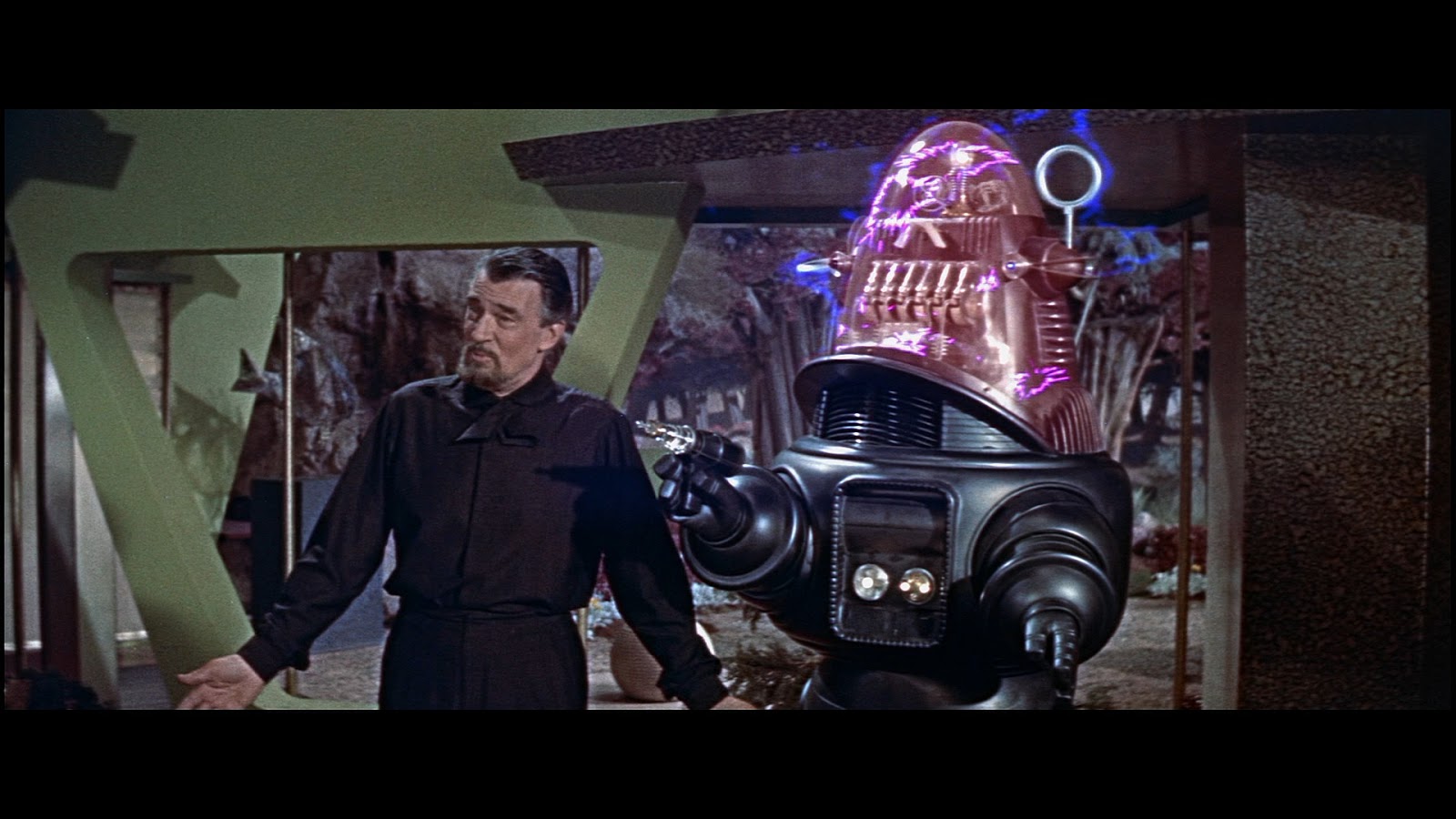 Mr Miniver and Robbie.
Mr Miniver and Robbie.
All the others from Expedition One were killed by some dark, unseen force. Only Miniver was spared, perhaps, thanks to his Dunkirk service. It is hard to believe. The Stranger from Venus would not buy it.
Francis has a tame tiger which later tries to attack her in the company of Drebin who keep showing her his interest. This is a harbinger of what is to come.
By some mystery the ship is damaged. Then two crewmen are murdered! Yikes! The flour is in the gravy now. Lumps and recriminations follow. Drebin shows more interest in Francis.
There is a marvellous scene where an invisible creature attacks the saucermen’s encampment. The pyrotechnics are startling. After the invisible creature, made visible in outline as it tries to cross a force field (the spaceman’s friend, along with Tums), kills two more red shirts, Bart Maverick, for reasons known only to the scriptwriter, rushes forward to meet it mano à mano and becomes, briefly, a roman candle. RIP Bart.
Now Miniver admits Robbie did not do it, that is, build everything in the sprawling ranch style home. The Krell and their wondrous machinery are revealed and displayed. Wow and wow! Many arresting visuals as Miniver does a show-and-tell. Key is the brain booster, which he has used to become an Egghead rivalling Kevin. He impressed Drebin with his knowledge of vexillology. vacuumology, ventriloquism, or something. No one ever explains Robbie’s origins. Is he Krell, or not?
 Brain booster. Get it?
Brain booster. Get it?
Every time Drebin shows his interest to Francis, something bad happens. (No, not that.) Stevens as the doctor figures it out. Sigmund Freud has been there and Prospero-Miniver, thanks to the brain booster, unconsciously projects the energy of his thoughts into actions to get the remoter. Evidently, he eliminated all the original party this way, too, probably so that he could watch what he wanted to watch and at full volume. Accidents happened, repeatedly.
Doc tries the brain booster without reading the manual. Bad idea. RIP Doc. Francis and Drebin plan to move to New Jersey. (Bad idea.) Miniver struggles and finally, taking a page from the playbook of James T. Kirk, Drebin talks Miniver to death by citing Ziggy in the original Incomprehensible. ‘Ugh,’ cried the fraternity brothers.
The survivors, accompanied by Miranda and Robbie, take off. Altair goes boom. Must have been New Year’s Eve. No one else will ever again be tempted to rival Kevin as a big brain by using the Krell device.
 ‘Home, Robbie,’ they cried.
‘Home, Robbie,’ they cried.
The end.
It always ranks near the top of lists of the best Sy Fy, the more so when CGIs cartoons are omitted. More than 30,000 ratings on the IMDb is something for a 1956 movie in this genre. It has a strong but surprising story line, some great visuals, an elaborate background, a slow build-up, and agreeable characters. The comic relief is mercifully brief.
It starts with a twist, putting Drebin in a flying saucer (rather than the aliens) and stays a little off-center of the genre conventions thereafter. Quibbles follow.
If Miniver wanted them to leave, why did he damage the ship, making it necessary for the ship to stay? Maybe he should have visited the big brain booster for a top-up on cause-and-effect.
But then why did id kill all the original survivors of the first mission? Was it really a fight to the death over the television remoter? That seemed likely to the fraternity brothers.
Yet many of the critics linked to the IMDb have some churlish and childish things to say. One derides it because the King Gee uniforms worn by the crew are not shiny. Yep crucial that. Another wants more creature and less feature. Back to the kindergarten with that 7MATE viewer. Another says Shakespeare was not much. [Gasp.] Others tell erring readers which sofa on which they sat to watch it. Crucial that. Others wanted more action and less thinking. Look in a mirror for that.
At the time of its release the pompous ‘New York Times’ reviewer Bosley Crowther waxed enthusiastic about it. Now that is odd. His reviews of Sy Fy were usually condescending, disdainful, and snide, altogether like some professors talking to undergraduates.
Ever after Drebin went to Police Academy to earn a living back in New Jersey, and Miranda set up as a PI in ‘Honey West.’ Miniver went to the Senate to ‘Advise and Consent’ and a reborn Bart went all ‘Maverick.’ None of the B Sy Fy regulars are in the cast.
Nor are any of the crew Sy Fyians. The screen writer, director, and producer were generalists with no Sy Fy visas in the CV. The soundtrack of tones is noteworthy, though where was the theremin?
‘Stranger from Venus’ (1954)
Metadata from the IMDb: 1 hour and 15 minutes, 5.4/10 from 294 viewers.
Patricia Neal, driving along a country lane, is blinded by an unexpected light and jerks the steering wheel. The automobile goes off the road and smashes into an inconveniently located oak tree. Wallop! Afterwards a copper examining the wreckage says no one could have survived that crash.

Yet later that afternoon Patricia walks into the pub with a few bumps and bruises. Earlier we saw feet approaching the smashed car with Pat sprawled across the steering wheel. When that copper arrived she is nowhere to be found and neither are those feet. ‘Where is Pat,’ asked the fraternity brothers?
Those are no ordinary feet.
They belong to a man who appears in the village and things gradually happen. He is a stranger, and he later tells the local that he is from Venice.
At the pub we have the local doctor, a stiff-legged publican, a barmaid, Mr Smarm who is Pat’s squeeze, and, shortly, two police officers from the site of the car wreck. Into this gathering walks the Stranger.
He is dead calm, two degrees below laconic. He sits. Yes, he would like a drink. Offered choices he chooses by pointing to a glass. Beer comes. Here is the first clue he is an alien. He says he does not like that (warm beer), Suspicious are aroused.
The doctor tries to chat him up. This stranger has no small talk. That is not all he does not have. ‘What’s your name?’ asks the quack. ‘I have no name.’ Oh, oh.
That is not all he does not have. The quack tries to take his pulse. No pulse.
Mr Smarm tells the cops to arrest the Stranger to find out who he really is and find where he has hidden his pulse. They discover they cannot touch him, try though they might. But he agrees to let them take his fingerprints. He has prints but not human. Well, of course not, he says, ‘I am from Venus.’ Oh, Venus! By now they believe him.
At times he can read minds, but at other times with no explanation he cannot. Blame the script writer or a low battery.
He has no money. Now that is serious in a pub. Who is going to pay for that undrunk beer! The Stranger suggests he work for his keep in the garden. He likes the garden and spends much time among the flowers while the others discuss their reactions to him. This quiet flora-loving stranger appeals to Pat. After Gort he is a change.
Smarm sees his career stock rising if he capitalise on this Venusian, but he does not seem to be jealous of Pat’s affections. Fool that he is! He can use this Stranger to become famous or something. He calls in heavy weights from the capital. The terms ‘London’ or ‘Whitehall’ are not used.
The Stranger says he wants to meet world leaders to explain his purpose once he recovers from flying saucer lag. Nuclear testing will alter the Earth’s orbit and such a change would have an impact on Venus as well as Venice. In return for putting aside nuclear weapons, Venus will help Earth develop other technologies (like solar and wind). A major delegation awaits in the mother ship once the Stranger has arranged a meeting.
The Heavy Weights say no world meeting can be arranged so quickly in the circumstances. Secretly they plot to lure the mothership into a trap so they can seize its technology. (Aside, technology transfer does not work that way. Give a caveman an iPhone and he will use it to spilt rocks. I have tried this with the fraternity brothers and confirmed this result.)
Wait! The Stranger has an iPhone that lights up when he communicates with the mother ship. When he loses it, he becomes animated for the first time.
It is slow without special effects. The Stranger does not have a shiny suit or any of the other paraphernalia of Sy Fy aliens. There are a lot of extras as soldiers surrounding the area and fencing it off. Many rustics are shown listening to radio reports. Much equipment is seen to be deployed and it does not look like stock footage. It hardly seems a cheap production as many critics claim. It does seem a story that does not need a lot of artifice.
The process by which the Stranger reveals his origins and convinces the others is compelling. The reactions of the members of the group in the pub are interesting, too. The scientists, the doctor and later a figure from the Ministry, believe the data about fingerprints and pulse. After a nocturnal visit from the Stranger, the publican regains full use of his stiff leg. He then is convinced. Others are slower to admit it.
The barmaid prays for guidance and then accepts him at face value as a gentle soul from God’s creation. No doubt acceptance would see it banned in Alabama where only the sins of football players and Twits are forgiven.
The setting is deliberately ambiguous and this subtlety has been lost on most critics. The radio announcer has a mid-Atlantic accent, Neal carries coal-country Kentucky in speech, the publican is very British, others are muted. Moreover, when the coppers come from the road accident they wear gaudy uniforms and carrying sidearms. These are not 1954 Bobbies. When the Heavy Weights arrive the offical car sports at tricolour flag, not the Onion Jack.
While a journalist is present, he waits for government permission from the Ministry of the Interior to publish. The village looks British to be sure, but there has never been a Ministry of Interior in the United Kingdom. What self-disrespecting Brit journalist ever waited for permission to publish? D-Notice be damned!
The setting is contemporary to 1954 but it is not quite England and certainly not the USA. Orthogonal rotation gives us a variant reality making the setting more general. This is not England, this is anywhere. Most of the critics seem to think these aspects are a result of the small budget, whereas I think they were contrived to add to the uncertainty, the mystery, and the strangeness. It works.
Some of the cockamamie interpretations by critics may stem from the origins of the film. Yes it is resonant of ‘The Day the Earth Stood Still’ (1951) though it stands on its own.
Yes, Patricia Neal plays a similar role in this outing as she did in ‘The Day Earth Stood Still’ though she has much less to do here. Whew! No Gort. She had moved to England with Roald Dahl and the gossip is that they bought a house and to pay for re-decorating and furnishing it, she went back to work. But of course the film world in Great Britain had a pecking order and she was not in it.
His Lordship Desmond Leslie, a specimen who defines the English eccentric, was a UFO devotee, and he set up a shelf company to produce this film Neal wanted work and he had just the thing for her.
Helmut Dantine plays the Stranger with an Austrian accent (though in one scene he switches through French, German, Spanish, and Russian to prove what an alien he is).

He had been imprisoned by the Gestapo for anti-Nazi activities after the Anschluss and it took a really big bribe to spring him; then he fled to England. He made a film career there in 1940s playing Naziis. Never a lead but always there in a dozen films in 1942 alone where on celluloid the Brits were clobbering the Nasties. Post war he moved to California in the hope of more and varied work in the bigger pool there but he never quite made it as an actor, and realising that he went into directing and later producing.
The film did not get a theatrical release in the United States, perhaps because Twentieth Century-Fox protected its investment in ‘The Day the Earth Stood Still’ or because there was no theremin music. It has been presented under other titles, e.g., ‘Immediate Disaster’ and ‘The Venusian’ on late night television.
Not easy to find and perhaps that explains the few IMDb comments and votes. I watched the version at the Internet Archive which seemed to be complete. There are edited versions about the gossip says.
‘Planeta Bur’ (1962)
This Soviet classic (‘Planet of Storms’) has been an undercover agent of influence in plain sight for years in the West as ‘Voyage to the Pre-Historic Planet’ (1965) and ‘Voyage to the Prehistoric Planet of Women’ (1968). The fraternity brothers have wall posters for the latter film. These latter two films were cut and pasted for English-speaking audiences. Sherlock Holmes put in an appearance in the former and Mamie van Doren in the latter. Wall poster, indeed.

Having feasted on these two simulacra, it was time for the subtitled original.
In 1962 the Soviet Union was winning the space race and to promote that achievement rubles flowed into science fiction movies like this one. When Neil Armstrong stepped onto the Moon, the ruble spigot was turned off.
Here is the set up. Three space ships are approaching Venus. While they are all crewed by Russians, there is someone who say ‘OK’ a lot and his name is Allan Kern. There is no military symbolism or insignia to be seen.
Maybe the effort is a combined international effort. The film opens abruptly and no explanation is given, though there are many references to the Earth rather than Russia.
Each ship has a crew of three. Wallop! Two ships remains. What else? A meteor clobbers one ship. The carefully contrived plan of landing is obliterated with it. Earth instructs the two remaining ships to wait two months while another space ship is launched and joins them.
Two months eating airline food and using that plumbing. No thanks! They come up with a new plan and Earth control rolls with it. (Sherlock did this part in one of the Cormanites.)
The he-men decide to leave one ship in orbit and to land with the other in two stages. First a surface lander will drop down to scout a spot with good duty free shopping, and then the second ship will land there. ‘OK,’ say Allan Kern.
The third member of one crew is a woman and she is left in orbit to communicate with Earth. Unlike the Yankee Sy Fy of the time there are no sexist remarks about a woman doing a man’s job, though she is the squeeze of the captain of her threesome, their relationship is chaste. So far so good. She is left in orbit not because she is a frail and flighty woman, but because she knows to turn on the radio as communications officer. Push the big red button. Ah huh. Nice try. That did not fool the fraternity brothers for one minute. She is left behind because she is frail and flighty woman.
While the men are resolute, she dithers later and in one light moment she floats around the cabin. None those resolute newish Soviet men would do that. Even so this subtlety is way beyond Hollywood at the time.
On Venus they find a lot of Godzilla’s cousins and fend them off, sometimes with revolvers. It is an inhospitable place, boiling mud, flowing lava, clinging plants, rubber dinosaurs, a lot like Wyoming. Kern has a big robot called ‘John’ who is snooty. Unless addressed politely by name, he ignores instructions. Think Siri, who does not react well to some of the things the fraternity brothers say to her. Robo John also serves as a mobile computer. Try putting him in a pocket. Robo John is useful but in the end it fails the Laws of Robotics. Bad robot!
Unlike so many British and Americans on other planets, these Soviets do show scientific interest in it, collect samples, discuss findings — when not hacking and shooting the fauna — and speculate about intelligent life. So many of the Anglo-Brit planeteers are bored, indifferent, napping, smoking, and lining up for the return trip without a backward glance.
The Soviet equipment was not made by the lower bidder, because it works, and they return to space, and presumably to Earth. But we get no triumphal return (unless I hit the off button, too soon).
They have a hovercraft that is also a submersible, though it is not quite up to James Bond-standard.
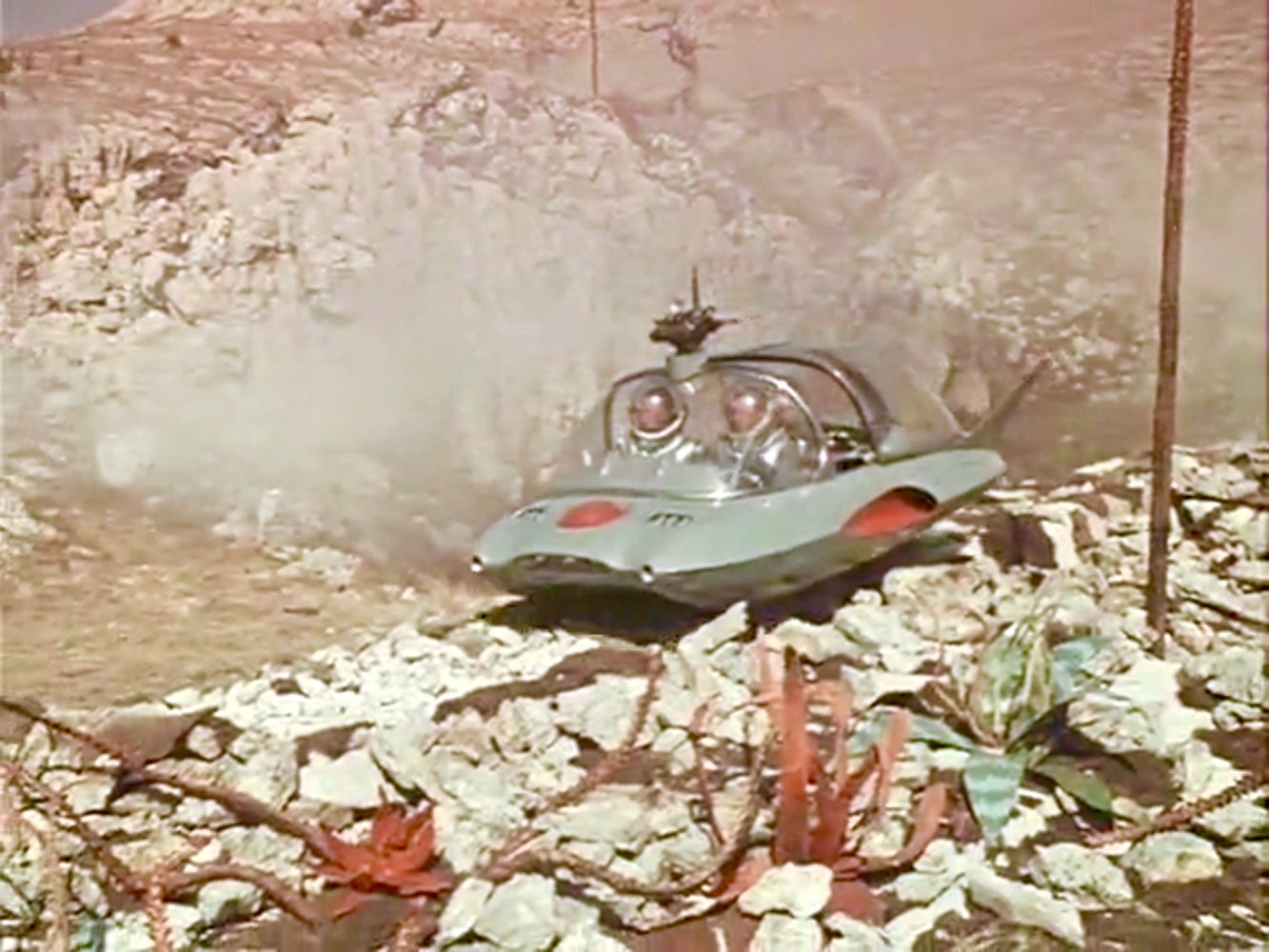
Even so the under water sequences are well done, As is the episode of weightlessness mentioned above. These effects would have been quite fascinating at the time. They still are considering there is not a CGI in sight.
As they leave the planet the ending is spooky, but it is not connected to the preceding story, and seems an afterthought, as though inviting Roget Corman to do what he did with it, and get two more movies out of it.
